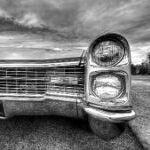1.) Most windshields are basically “parallelograms”, IE; though there is often a minor arc to a given side, they still present themselves as ‘rectangular’ to the eye.
This is the 1954 Kaiser, which shows the feature Kaiser used since 1950; nicknamed the ‘Sweetheart’ windshield. Note the obvious double-arc’d top edge of the glass. For the sake of this question, we’re calling it a ‘non-parallelogram’.
Is there a more recent vehicle with a similar “non-parallelogram’ windshield? If so; name it.
2.) How is it factually possible that Chevrolet did NOT have a small block V8 in 1955 in the U.S.?
3.) Which GM Divisions built both small block and big block V8s in the 1960s?
4.) First post-war U.S. make/model to feature a speedometer marked higher than 120 MPH.
5.) 'Body by Fisher' and 'Body by Fleetwood' were two common badges found on certain GM cars. There was a third 'Body by —' tag found for many years on GM vehicles- what did it read?








-3707742431.jpg.06edf8e14f4ccf35c60d4774a543cc11.jpg)


Recommended Comments
Join the conversation
You can post now and register later. If you have an account, sign in now to post with your account.
Note: Your post will require moderator approval before it will be visible.